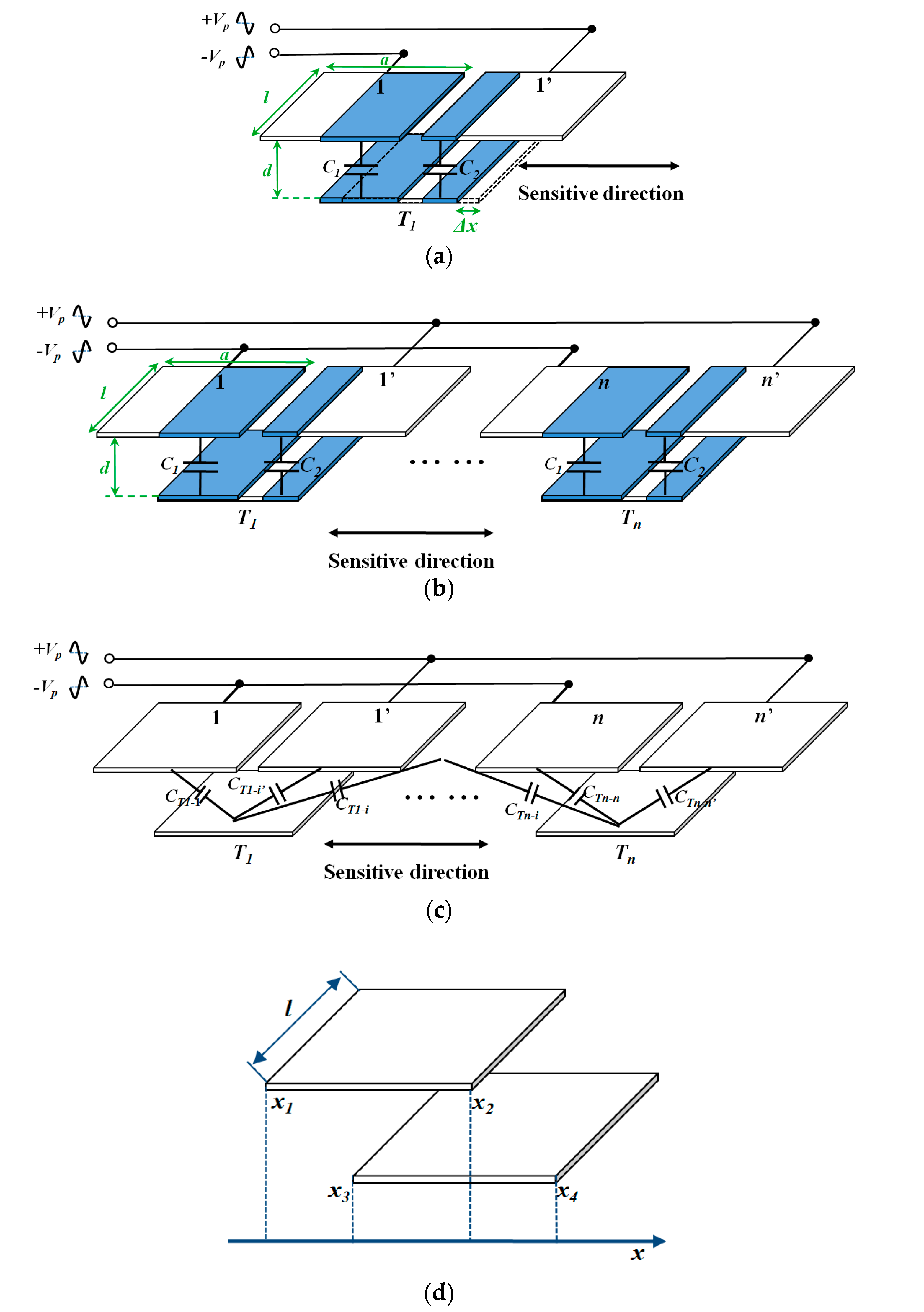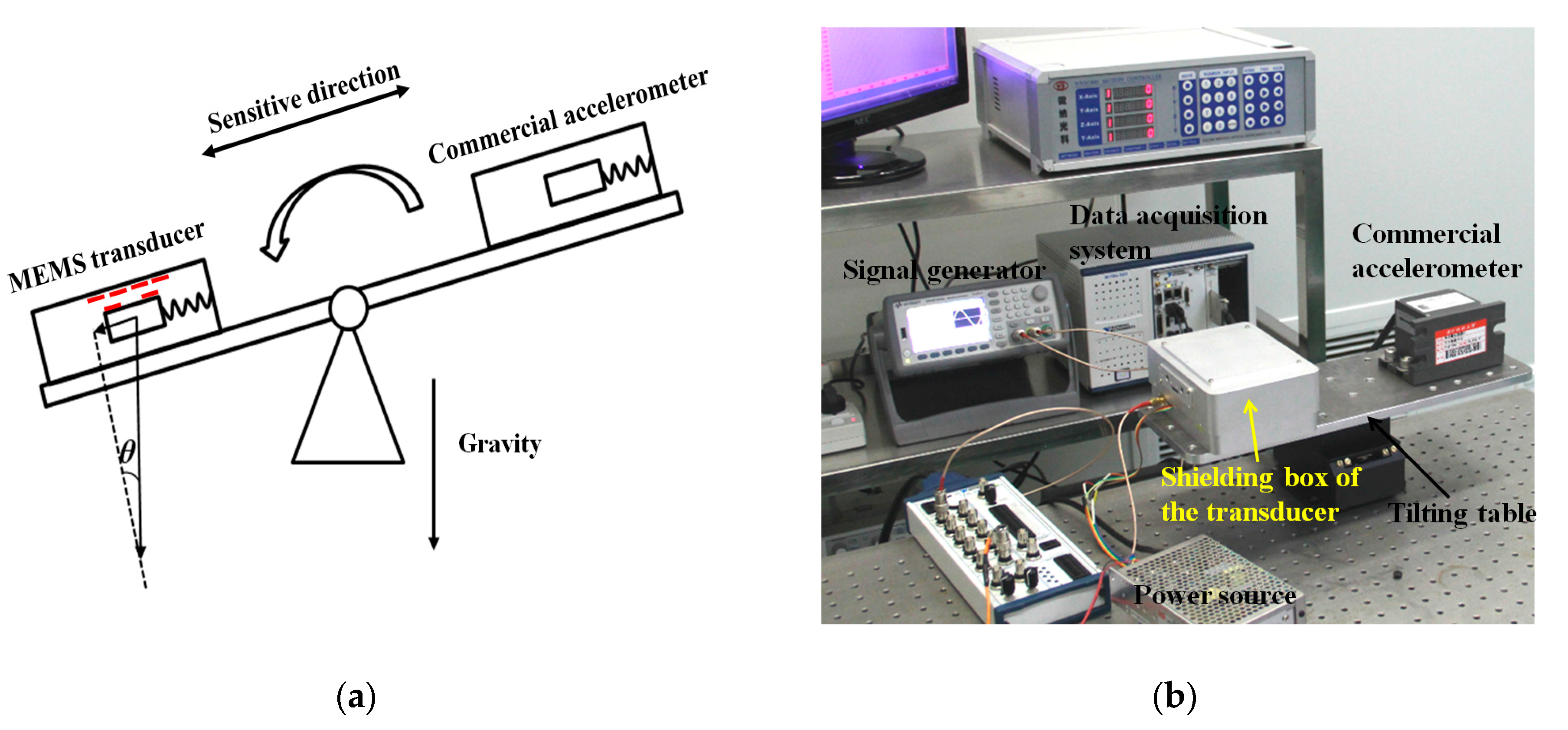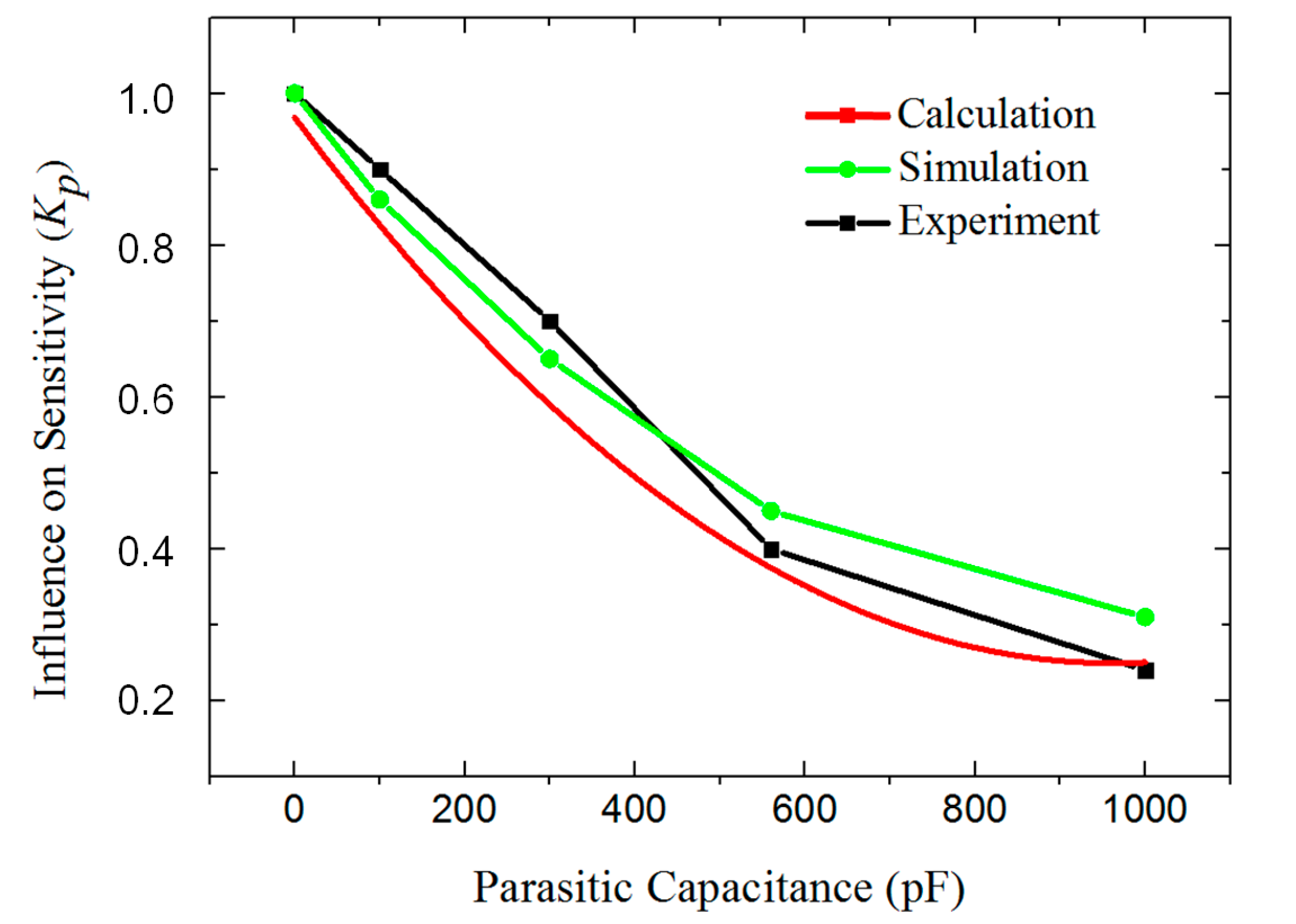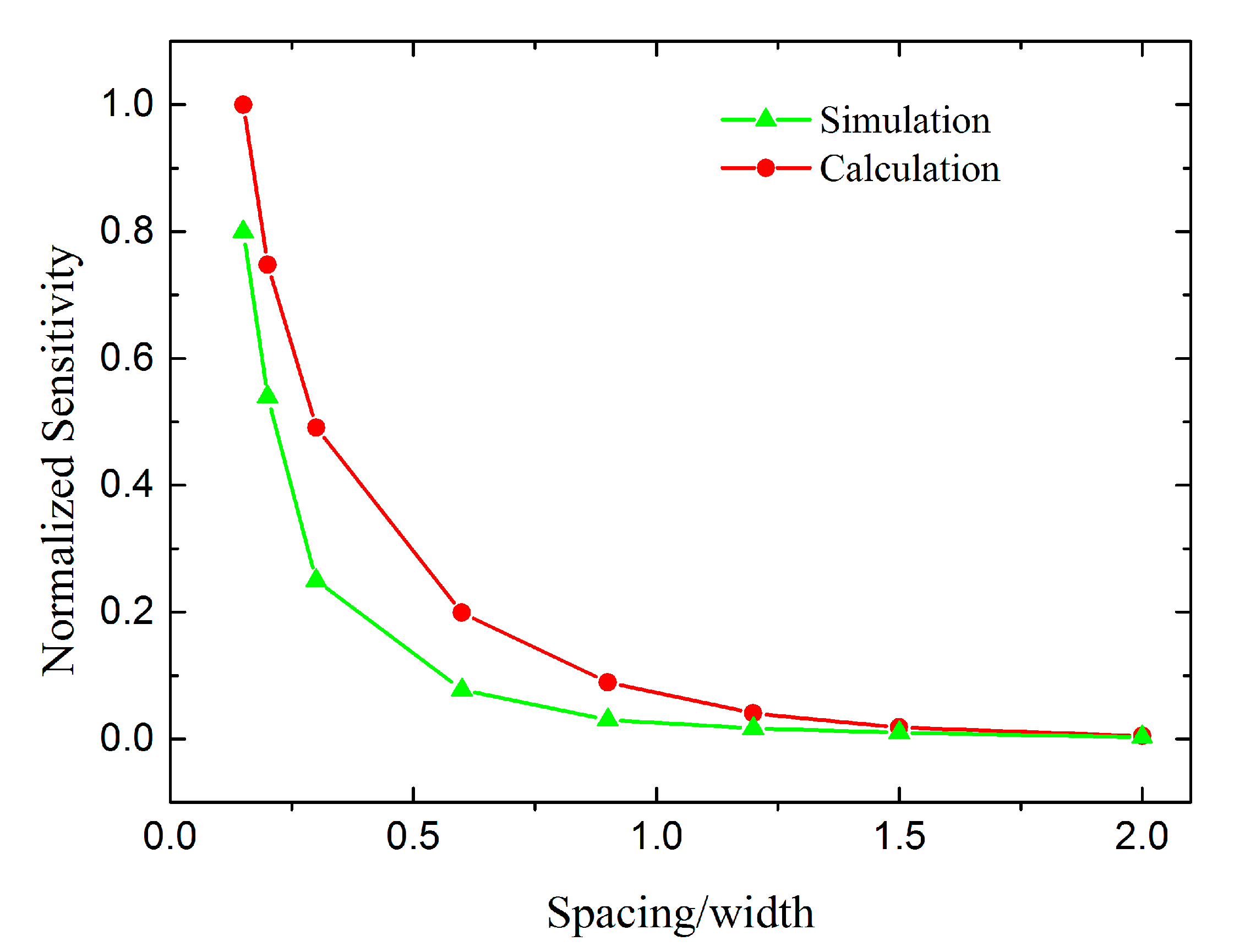High-Sensitivity Encoder-Like Micro Area-Changed Capacitive Transducer for a Nano-g Micro Accelerometer
Abstract
:1. Introduction
2. Theoretical Analysis, Simulations and Experiments
2.1. Parasitic Capacitance
2.1.1. Model and Calculations
2.1.2. Simulation and Experiments
2.2. Capacitance of the Fringe Effect
2.3. Fabrication and Testing
3. Results
4. Conclusions
Acknowledgments
Author Contributions
Conflicts of Interest
References
- Fleming, A.J. A review of nanometer resolution position sensors: Operation and performance. Sens. Actuators A Phys. 2013, 190, 106–126. [Google Scholar] [CrossRef]
- Salapaka, S.; Sebastian, A.; Cleveland, J.P.; Salapaka, M.V. High bandwidth nano-positioner: A robust control approach. Rev. Sci. Instrum. 2002, 73, 3232. [Google Scholar] [CrossRef]
- Yazdi, N.; Ayazi, F.; Najafi, K. Micromachined inertial sensors. Proc. IEEE 1998, 86, 1640–1658. [Google Scholar] [CrossRef]
- Middlemiss, R.P.; Samarelli, A.; Paul, D.J.; Hough, J.; Rowan, S.; Hammond, G.D. The first measurement of the earth tides with a mems gravimeter. Nature 2016, 531, 614–617. [Google Scholar] [CrossRef] [PubMed]
- Petersen, K.E. Silicon as a mechanical material. Proc. IEEE 1982, 70, 420–457. [Google Scholar] [CrossRef]
- Liu, H.; Pike, W.T.; Dou, G. A seesaw-lever force-balancing suspension design for space and terrestrial gravity-gradient sensing. J. Appl. Phys. 2016, 119, 124508. [Google Scholar] [CrossRef]
- Sun, Z.; Li, G.; Chen, L.; Chen, D.; Wang, J.; Chen, J. A high-consistency broadband mems-based electrochemical seismometer with integrated planar microelectrodes. IEEE Trans. Electron Devices 2017, 64, 3829–3835. [Google Scholar] [CrossRef]
- Alshehri, A.; Almutairi, B.; Gardonio, P.; Kraft, M. Two-degree of freedom capacitive MEMS velocity sensor with two coupled electrically isolated mass-spring-damper systems. In Proceedings of the 2014 IEEE Conferences on Sensors, Valencia, Spain, 2–5 November 2014; pp. 1603–1606. [Google Scholar]
- Chen, T.; Wang, Y.; Liu, H.; Yang, Z.; Wang, P.; Sun, L. Topologically optimized nano-positioning stage integrating with a capacitive comb sensor. Sensors 2017, 17, 257. [Google Scholar] [CrossRef] [PubMed]
- Benevicius, V.; Ostasevicius, V.; Gaidys, R. Identification of capacitive MEMS accelerometer structure parameters for human body dynamics measurements. Sensors 2013, 13, 11184–11195. [Google Scholar] [CrossRef] [PubMed]
- Liu, C.H.; Kenny, T.W. A high-precision, wide-bandwidth micromachined tunneling accelerometer. J. Microelectromech. Syst. 2001, 10, 425–433. [Google Scholar]
- Baxter, L. Capacitive Sensors: Design and Applications; Wiley-IEEE Press: Piscataway, NJ, USA, 1997; pp. 37–47. [Google Scholar]
- Wu, J.; Feeder, G.K.; Carley, L.R. A low-noise low-offset capacitive sensing amplifier for a 50-μg/√hz monolithic CMOS MEMS accelerometer. IEEE J. Solid-State Circuits 2004, 39, 722–730. [Google Scholar]
- Bais, B.; Majlis, B.Y. Low-g area-changed MEMS accelerometer using bulk silicon technique. Am. J. Appl. Sci. 2008, 5, 626–632. [Google Scholar]
- Lee, J.; Huang, X.; Chu, P.B. Nanoprecision MEMS capacitive sensor for linear and rotational positioning. J. Microelectromech. Syst. 2009, 18, 660–670. [Google Scholar] [CrossRef]
- Prakash, S.B.; Abshire, P.A.; Nabovati, G.; Ghafar-Zadeh, E.; Mirzaei, M. Charge-based capacitive sensor array for CMOS-based laboratory-on-chip applications. IEEE J. Solid-State Circuits 2014, 33, 325–332. [Google Scholar]
- Pedrocchi, A.; Hoen, S.; Ferrigno, G.; Pedotti, A. Perspectives on MEMS in bioengineering: A novel capacitive position microsensor. IEEE Trans. Biomed. Eng. 2000, 47, 8–11. [Google Scholar] [CrossRef] [PubMed]
- Pike, W.T.; Delahunty, A.K.; Mukherjee, A.; Standley, I.M. A self-levelling nano-g silicon seismometer. Proc. IEEE Sens. 2014, 1599–1602. [Google Scholar]
- Milligan, D.J.; Homeijer, B.D.; Walmsley, R.G. An ultra-low noise MEMS accelerometer for seismic imaging. Proc. IEEE Sens. 2011, 1281–1284. [Google Scholar]
- Liu, H.; Pike, W.T. A micromachined angular-acceleration sensor for geophysical applications. Appl. Phys. Lett. 2016, 109, 173506. [Google Scholar] [CrossRef]
- Li, B.; Lu, D.; Wang, W. Micromachined accelerometer with area-changed capacitance. Mechatronics 2001, 11, 811–819. [Google Scholar] [CrossRef]
- Yazdi, N.; Kulah, H.; Najafi, K. Precision readout circuits for capacitive microaccelerometers. Proc. IEEE Sens. 2004, 28–31. [Google Scholar]
- Heerens, W.C. Application of capacitance techniques in sensor design. J. Phys. E: Sci. Instrum. 1986, 19, 897. [Google Scholar] [CrossRef]
- Kim, M.; Moon, W.; Yoon, E.; Lee, K.R. A new capacitive displacement sensor with high accuracy and long-range. Sens. Actuators A: Phys. 2006, 135–141. [Google Scholar] [CrossRef]
- Kang, D.; Lee, W.; Moon, W. A technique for drift compensation of an area-varying capacitive displacement sensor for nano-metrology. Procedia Eng. 2010, 5, 412–415. [Google Scholar] [CrossRef]
- Yang, H.; Li, W.K. Structure and Method to Use Low k Stress Liner to Reduce Parasitic Capacitance. Available online: https://www.google.com/patents/US7790540 (accessed on 18 Steptember 2017).
- Neugebauer, T.C.; Perreault, D.J. Parasitic capacitance cancellation in filter inductors. IEEE Trans. Power Electron. 2006, 21, 282–288. [Google Scholar] [CrossRef]
- Wu, W.J.; Zhu, T.; Liu, J.Q.; Fan, J.; Tu, L.C. Polyimide-damage-free, CMOS-compatible removal of polymer residues from deep reactive ion etching passivation. J. Electron. Mater. 2015, 44, 991–998. [Google Scholar] [CrossRef]
- Fan, J.; Zhu, T.; Wu, W.J.; Tang, S.H.; Liu, J.Q.; Tu, L.C. Low temperature photosensitive polyimide based insulating layer formation for microelectromechanical systems applications. J. Electron. Mater. 2015, 44, 4891–4897. [Google Scholar] [CrossRef]
- Li, Z.; Wu, W.J.; Zheng, P.P.; Liu, J.Q.; Fan, J.; Tu, L.C. Novel capacitive sensing system design of a microelectromechanical systems accelerometer for gravity measurement applications. Micromachines 2016, 7, 167. [Google Scholar] [CrossRef]
- Liu, J.Q.; Wang, C.; Zhu, T.; Wu, W.J.; Fan, J.; Tu, L.C. Low temperature fabrication and doping concentration analysis of Au/Sb ohmic contacts to n -type Si. AIP Adv. 2015, 5, 117112. [Google Scholar] [CrossRef]












| Component | Value | Unit |
|---|---|---|
| Resistance of the wire (R1, R2) | 20 | Ohm |
| Original capacitance (C0) | 4 | pF |
| Resistance of the wire (R3) | 770 | Ohm |
| Parasitic capacitance (Cp1, Cp2) | 100 | pF |
| Parasitic capacitance pre-optimization (Cp3) | 1000 | pF |
| Parasitic capacitance post-optimization (Cp3’) | 406 | pF |
| Feedback capacitance (Cf) | 2 | pF |
| Feedback resistance (R4) | 100 M | Ohm |
| Gain of the amplifier at 100 kHz (A) | 158 | V/V |
| Component | Value | Unit |
|---|---|---|
| Thickness of SiO2 | 0.2 | μm |
| Thickness of electrodes | 0.4 | μm |
| Thickness of the PSPI | 3 | μm |
| Solder bonding thickness pre-optimization | 90 | μm |
| Solder bonding thickness post-optimization | 20 | μm |
| Dimension of a single electrode | 0.1 × 0.3 | mm |
| Width of spring | 42 | μm |
| Length of spring | 9 | mm |
| Number of springs on both side of proof mass | 12 | pair |
| Number of arrayed capacitors (n) | 45 | - |
| Length of the electrode (l) | 3 | mm |
| Width of a single electrode (a) | 0.1 | mm |
| Capacitors spacing pre-optimization (d) | 90 | μm |
| Capacitor spacing post-optimization (d’) | 30 | μm |
| Thickness of the silicon substrate | 500 | μm |
| Mass of the proof mass (m) | 0.4 | g |
| Frequency of the spring-mass structure (f) | 15 | Hz |
© 2017 by the authors. Licensee MDPI, Basel, Switzerland. This article is an open access article distributed under the terms and conditions of the Creative Commons Attribution (CC BY) license (http://creativecommons.org/licenses/by/4.0/).
Share and Cite
Wu, W.; Zheng, P.; Liu, J.; Li, Z.; Fan, J.; Liu, H.; Tu, L. High-Sensitivity Encoder-Like Micro Area-Changed Capacitive Transducer for a Nano-g Micro Accelerometer. Sensors 2017, 17, 2158. https://doi.org/10.3390/s17092158
Wu W, Zheng P, Liu J, Li Z, Fan J, Liu H, Tu L. High-Sensitivity Encoder-Like Micro Area-Changed Capacitive Transducer for a Nano-g Micro Accelerometer. Sensors. 2017; 17(9):2158. https://doi.org/10.3390/s17092158
Chicago/Turabian StyleWu, Wenjie, Panpan Zheng, Jinquan Liu, Zhu Li, Ji Fan, Huafeng Liu, and Liangcheng Tu. 2017. "High-Sensitivity Encoder-Like Micro Area-Changed Capacitive Transducer for a Nano-g Micro Accelerometer" Sensors 17, no. 9: 2158. https://doi.org/10.3390/s17092158





